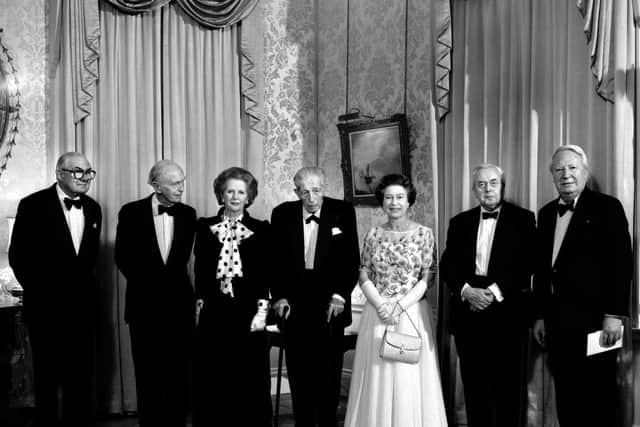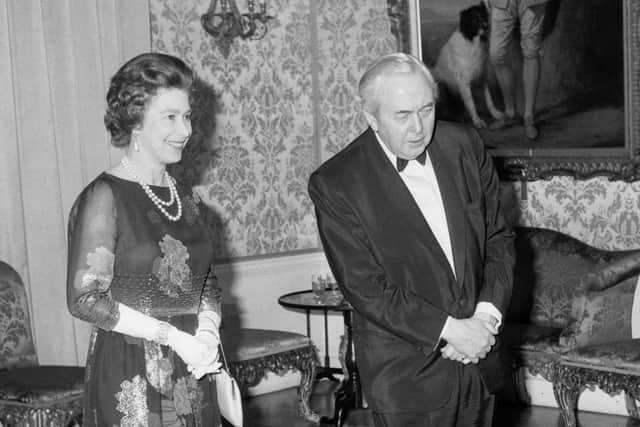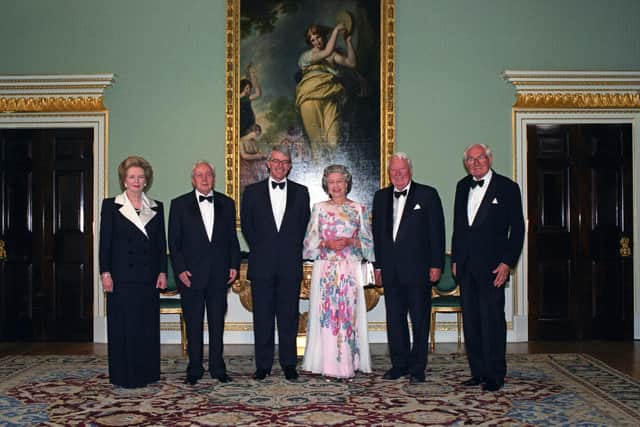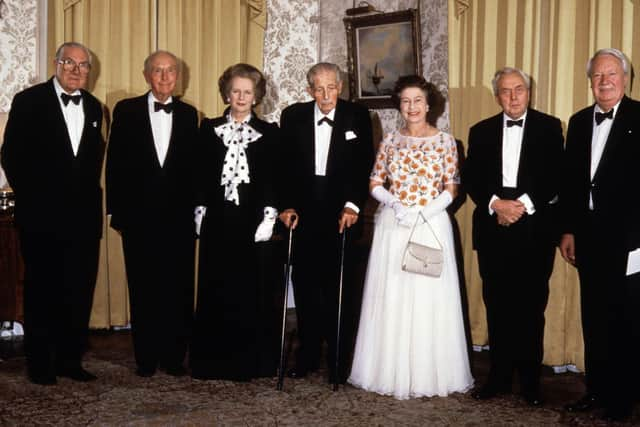Platinum Jubilee: The history of Queen Elizabeth II and her 14 Prime Ministers
Boris Johnson is, by far, the most unconventional of the 14 prime ministers who have served the Queen during her 70-year reign.
Yet, while his chaotic Bertie Wooster-like demeanour might be the source of gentle humour inside the Royal palaces, he’s also one of the leaders who has drawn Her Majesty into major political controversy.
Advertisement
Hide AdAdvertisement
Hide AdThe Tory leader had to apologise to the Queen when his advice to prorogue Parliament in September 2019, in order to attempt to break the Brexit impasse, was ruled unlawful by the Supreme Court.


More recently, he had to be restrained from attending a weekly audience at Buckingham Palace at the start of pandemic because Downing Street was already known to be a Covid hotspot.
Little definitive has emerged about the Queen and Mr Johnson’s working relationship – not least because their meetings have been restricted by the lockdown and Her Majesty’s strict adherence to the rules at Windsor Castle.
Yet it is Mr Johnson’s hero Sir Winston Churchill, the first of the Queen’s premiers, who is widely credited with the biggest influence.


Advertisement
Hide AdAdvertisement
Hide AdHe came to know the young Princess Elizabeth during the Second World War and it fell to Sir Winston to greet the young, grieving monarch back on British soil after her sudden return from Kenya following the death of her father, King George VI, on February 6, 1952.
When Sir Winston retired in 1955, the Queen sent him a hand-written letter telling him how much she missed him and how no successor “will ever for me be able to hold the place of my first Prime Minister, to whom both my husband and I owe so much and for whose wise guidance during the early years of my reign I shall always be so profoundly grateful”.
By contrast, the Queen’s relationship with the starchy Sir Anthony Eden was certainly more formal, while Harold Macmillan was an urbane figure in contrast to the monarch who remains a countrywoman at heart.
Sir Alec Douglas-Home reportedly met with royal approval. An aide said: “He was an old friend. They talked about dogs and shooting together. They were both Scottish landowners, the same sort of people, like old schoolfriends.”


Advertisement
Hide AdAdvertisement
Hide AdHarold Wilson, the last Yorkshire-born PM, endeared himself to the Queen. “They got on like a house on fire,” one long-standing member of the Labour Party said.
He used to join members of the royal family for riverside picnics at Balmoral. However, Sir Edward Heath is said to have struggled with small talk and their weekly audiences have been described as “frosty”.
James Callaghan managed to establish a warm rapport. He said about the Queen: “One of the great things about her is that she always seems able to see the funny side of life. All the conversations were very enjoyable.”
His presence at the Prime Minister’s traditional September weekend at Balmoral meant the Queen could not attend the St Leger at Doncaster to watch her champion horse Dunfermline win the world’s oldest Classic.


Advertisement
Hide AdAdvertisement
Hide AdBut things were very different with Margaret Thatcher, who found these weekends to be an ordeal. One observer wrote: “A weekend in the country with aristocrats who enjoy riding, shooting, sports and games is Thatcher’s idea of torture.”
Mrs Thatcher also could not abide the charades that she was expected to play after dinner and once the Queen, at a gathering of six of her premiers, joked about “the party games which some of you have so nobly endured at Balmoral”.
When Baroness Thatcher died in April 2013, the Queen took the unusual step of attending her ceremonial funeral - a personal decision and an indication of the Queen’s respect for her first female prime minister.
The respect was mutual and expressed by Margaret Thatcher in The Downing Street Years where she described the importance of prime ministers having formal, and informal, meetings with the Queen.
Advertisement
Hide AdAdvertisement
Hide Ad“Anyone who imagines that they are a mere formality or confined social niceties is quite wrong: they are quite businesslike and Her Majesty brings to bear a formidable grasp of current issues and breadth of experience,” she observed.
“And although the press could not resist the temptation to suggest disputes between the Palace and Downing Street, especially on Commonwealth affairs, I always found the Queen’s attitude towards the work of government absolutely correct.”
Meanwhile the memoir of Baroness Thatcher’s successor John Major describes how he kept the Queen informed of developments on Black Wednesday in 1992 when financial turmoil forced the UK Government to withdraw from the European Exchange Rate Mechanism.
“I was, as always, frank, with the Queen, and set out the extent of the reversal for the government,” said Sir John who advised, correctly as events proved, that it would necessitate an early election.
Advertisement
Hide AdAdvertisement
Hide AdHowever Sir John was said to be popular with the Royal family, and the Queen in particular, because of how he handled the divorce of the Prince and Princess of Wales.
He also became a special guardian to Princes William and Harry when their mother Diana was tragically killed in a Paris car crash in August 1997.
Meanwhile the newly-knighted Sir Tony Blair’s relationship with the Queen was, first and foremost, shaped by the outpouring of grief that followed Diana’s death – and whether the Royal family needed to show more empathy with a grieving nation.
This came less than four months after New Labour’s landslide election win when the Queen famously advised her new premier: “You are my tenth prime minister. The first was Winston Churchill. That was before you were born.”
Advertisement
Hide AdAdvertisement
Hide AdThis directness took Mr Blair by surprise. He also wrote in his autobiography that he found the Queen to be “quite shy” on this occasion.
There was also an uneasiness when the Blairs visited Balmoral immediately after Diana’s funeral. “To reiterate, I barely knew the Queen at this point,” wrote Sir Tony.
“Had it all happened some years later, I would have been at ease and found it perfectly fine, to be frank. At this encounter, with recent events still raw and the relationship in its infancy, I felt nervous. She did so too.
“I talked, perhaps less sensitively than I should have, about the need to learn lessons. I worried afterwards she would think I was lecturing her or being presumptuous, and at points during the conversation she assumed a certain hauteur, but in the end she herself said lessons must be learned and I could see her own wisdom at work, reflecting, considering and adjusting.”
Advertisement
Hide AdAdvertisement
Hide AdMeanwhile Gordon Brown almost caused a constitutional crisis after Labour lost its majority in the 2010 election – he resigned as PM before his successor David Cameron had formalised a coalition between the Tories and Lib Dems.
Mr Cameron was also forced to make a grovelling apology to the Queen in 2014 after being caught on camera telling then New York mayor Michael Bloomberg that the monarch had “purred down the line” when he phoned Her Majesty to inform her that Scottish voters had rejected independence in a referendum.
In his book, For The Record, Mr Cameron said he prepared for his audiences by watching the BBC news at 6pm and checking the racing results to see if any of the Queen’s horses had won – or given birth to a foal.
“The week after my father died, the Queen said how sorry she was, and asked if his horse was running at Windsor that evening. It was. I had absolutely no idea about it and was completely lost for words,” he admitted.
Advertisement
Hide AdAdvertisement
Hide AdTheresa May was the second female prime minister of the Queen’s reign – taking up her post in July 2016 in the wake of the Brexit vote.
She paid a moving tribute to Prince Philip after the Duke of Edinburgh, the Queen’s husband of 73 years, died last April aged 99.
“It is in no way comparable, but I do know how important it is to have a husband – a partner – who is a source of strength and a rock in times of trouble,” said Mrs May.
Now, as Boris Johnson fights to save his premiership over the ‘partygate’ scandal, the question is which politician might ultimately receive a telephone call and be summonsed to Buckingham Palace to become the 15th prime minister of the Queen’s reign.
Comment Guidelines
National World encourages reader discussion on our stories. User feedback, insights and back-and-forth exchanges add a rich layer of context to reporting. Please review our Community Guidelines before commenting.